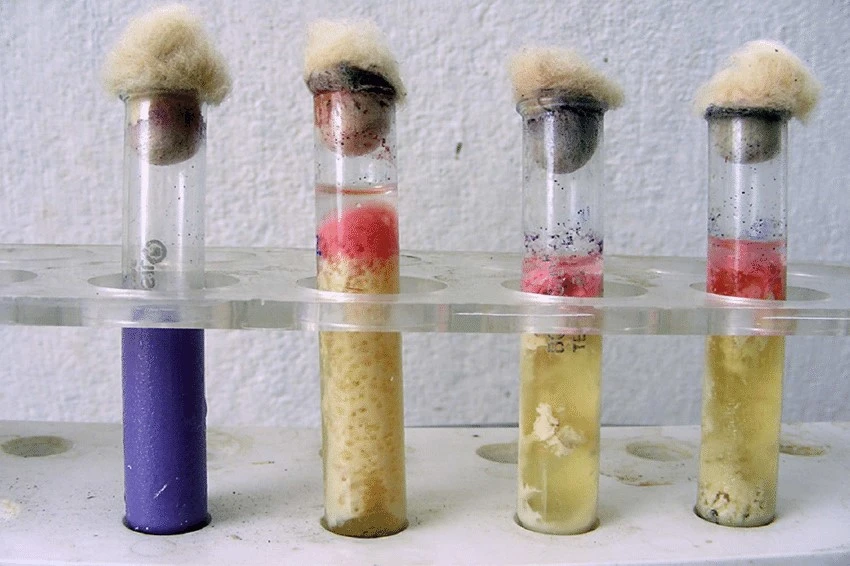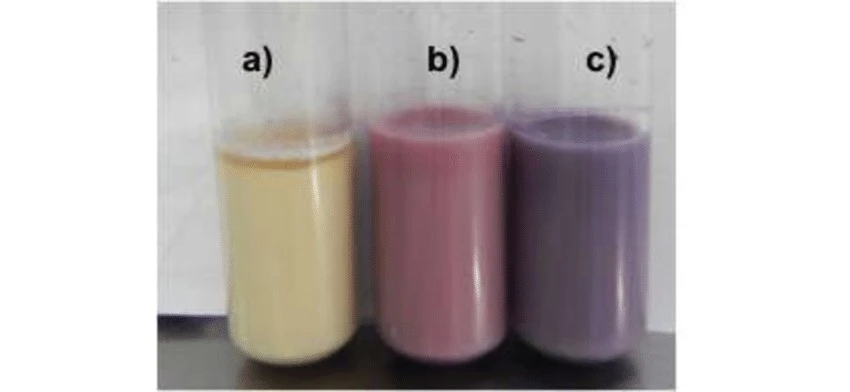Introduction
The Litmus Milk Test is a basic microbiology procedure that is critical for understanding how microbes metabolize nutrients and create acids, bases, and other byproducts. In this quick review, we’ll look at the concepts and importance of this flexible test for detecting and classifying microorganisms, which may be used for everything from food production to disease research.
Litmus milk is a milk-based medium with no specific name that contains skim milk and the pH indicator azolitmin (litmus). At pH 4.5, azolitmin is pink, while at pH 8.3, it is blue. It is purple between these two pH limits. Litmus is also an Eh (oxidation-reduction) indicator in addition to a pH indicator. Reduced litmus appears white, whilst oxidized litmus appears purple.
Microorganisms are distinguished by their ability to metabolize milk in litmus milk media. Lactose fermentation, litmus reduction, casein coagulation, and casein hydrolysis are four important events in litmus milk. The combination of these processes produces several outcomes, each of which can be used to differentiate microorganisms.
Litmus milk test objectives
- To distinguish bacteria based on metabolic processes in milk such as fermentation, reduction, clot formation, digestion, and gas generation.
- Litmus Milk test is largely used to distinguish members of the genus Clostridium.
- It distinguishes Enterobacteriaceae from other Gram-negative bacilli based on enteric bacteria ability to decrease litmus.
- Litmus Milk is also used to produce and maintain lactic acid bacteria cultures.
Principle of litmus milk test
This test examines the ability of an organism to metabolize milk. The Litmus Milk test is composed of four basic reactions: lactose fermentation, casein coagulation, litmus reduction and casein hydrolysis.
Fermentation of lactose
When the litmus turns pink due to acid formation, it indicates Lactose fermentation. If there is enough acid developed, casein in the milk precipitates and forms an acid clot. Depending on the oxidation-reduction status of litmus, acid clots solidify medium and can appear pink or white with a pink band at the top. Alkaline conditions can dissolve acid clots. Gas production is indicated by fissures or splits in the clot. Stormy fermentation refers to the creation of large amounts of gas that break up the clot. Clostridium perfringens is known for its stormy fermentation of litmus milk.
Coagulation of Casein
Some bacteria produce proteolytic enzymes (caseases) that coagulate casein and form a curd, such as rennin, pepsin, or chymotrypsin. A curd is distinguished from an acid clot by its inability to break down under alkaline environments. In case of some species, the curd shrinks, forming a straw-colored fluid named as whey at the surface.
Reduction of litmus
Litmus is reduced by some bacteria. If the reduction rate of litmus increases during lactose fermentation, it will turn the medium white in the lower tube area.
Hydrolysis of Casein
Some bacteria produce caseases, which hydrolyze casein, resulting in straw-colored milk that resembles turbid serum. Bacteria that can only partially digest casein generate ammonia (NH3), which raises the pH of the medium and causes the litmus to turn blue. An alkaline reaction is indicated by the formation of a blue or purple ring at the top of the clear fluid or the bluing of the entire medium.
Requirements for litmus milk test
- Test specimen
- Inoculating loop/ dropper
- Litmus Milk Medium
- Incubator
- Bunsen burner
- Control strains like Escherichia coli , Clostridium innocuum , Clostridium perfringens , Pseudomonas aeruginosa
Litmus milk composition
| Ingredients | Grams/100ml |
| Skim milk powder: 10.0 | 10 |
| Sodium sulfite | 0.05 |
| Litmus | 0.05 |
| Final pH should be 6.8±0.2 at room temperature | |
Litmus milk Preparation
- Suspend 10.1 g skim milk powder, sodium sulfite and litmus (as mentioned in composition) in 100 mL distilled water.
- Continuously stir the mixture.
- Dispense 10 mL into 15 x 150 mm tubes.
- Autoclave the medium at 15 lbs. pressure (121°C) for 5 minutes to sterilize it. Do not overheat.
Litmus milk test storage
- Store at 2-8ºC and keep out of direct sunlight.
- If there are any symptoms of deterioration (discoloration) or contamination, the media should not be used.
- The product is sensitive to light and temperature; protect it from light, high heat, moisture and freezing.
Procedure of litmus milk test
- Inoculate a litmus milk medium with four drops of 24-hour broth culture.
- Incubate at 35°C to 37°C in room temperature.
- For seven days, observe and document all changes.
- Look for alkaline (blue) and acid (pink) reactions, as well as litmus reduction, peptonization (The breakdown of a protein into peptones by the enzyme pepsin), rennet clot, and acid clot. Several changes may occur during the observation time.
Litmus milk test interpretation
| Color | Interpretation |
| Pinkish-red | Acid reaction, fermentation of lactose |
| Cracks formation | An excessive amount of gas generation ruptured an acid clot. |
| Blue | Alkaline reaction, there is no fermentation, organisms attack on nitrogenous substances present in the medium |
| White | The enzyme reductase converts litmus to a white base. |
| No change in color and consistency | Negative results |
| A clot or formation of curd | Coagulation of milk protein |
| Not pink and Semi solid, grey or clear fluid on top | Curd |
| Peptonization | Digestion of milk protein |
| Broken apart clots | Stormy formation |
| CO2 and H2 | Bubbles in the medium, breaking of clot |
Positive test
- Acidic pH: pink – red color
- Alkaline pH: purple to blue color
- Reduction: white color
- Acid curd: hard curd and whey (clear supernatant)
- Digestion: Clot dissolution with a transparent, greyish, watery fluid and a shrunken, insoluble pink clot
- Rennet curd: Soft curd is followed by peptonization (alkaline pH, brown supernatant).
- Gas production: coagulated milk having bubbles
Negative test
Color and consistency do not change


Response of control strains
- Escherichia coli gives an Acidic reaction
- Clostridium innocuum gives Alkaline reaction
- Pseudomonas aeruginosa gives Peptonization reaction
- Clostridium perfringens gives an Acidic reaction with clotting and digestion
Importance of litmus milk test
- This test is mostly used to distinguish members of the genus Clostridium, and it can also distinguish Enterobacteriaceae from other Gram-negative bacilli.
- Litmus milk can also cultivate and sustains lactic acid bacteria cultures.
Advantages of litmus milk test
- It is a differentiated media for determining several metabolic functions.
- It is used for lactobacilli cultivation and maintenance.
- It is used to distinguish bacteria based on metabolic processes in litmus milk such as fermentation, reduction, clot formation, digestion, and gas generation.
- The test aids in determining the quality of milk and dairy products. Changes in litmus milk that are undesirable can indicate bacterial contamination or deterioration.
- It helps in the research of microbial metabolic processes in various habitats such as soil, water, and the human gut.
- The test can help with disease diagnosis and therapy by identifying pathogenic microorganisms and their virulence factors.
- It is used to ensure the quality of pharmaceutical products, particularly those using microbial fermentation methods.
Disadvantages of litmus milk test
- Litmus media reactions are not specific and should be supplemented with further tests to determine the identity of microorganisms.
- The Litmus Milk Test results are frequently dependent on visual observations, individuals may interpret color changes differently, and that can result in reporting wrong interpretation.
- The test needs a 24-to-48-hour incubation period, which can be time-consuming. This can be a disadvantage in a healthcare context when speedy identification is essential.
- The Litmus Milk Test may not be appropriate for all bacteria. Because some bacteria do not cause significant metabolic changes in milk, the test is unhelpful in identifying them.
- Preparing and maintaining a litmus milk medium can be time-consuming, as particular materials and equipment are required. As a result, smaller laboratories or research centers with limited resources may find it more difficult to access.
Quality control of litmus milk test
- For quality control of the Litmus Milk Medium Test, the following bacteria can be used: Fermentation: Clostridium perfringens — gas generation, Lactobacillus acidophilus — clot formation, and Pseudomonas aeruginosa .
- Because the litmus milk test is not specific, it should be followed up with other tests for conclusive identification of microbes.
- If Clostridium is suspected or anaerobiosis is desired, immediately after inoculation add sterile reduced iron (e.g., iron powder, nails, paper clips, metal filings) to the tube or pour a layer of sterile mineral oil over the medium surface.
Precautions for litmus milk test
- To prevent contamination from external microorganisms, which can interfere with the results, aseptic (sterile) methodology must be maintained throughout the test.
- Ensure that the incubation temperature is constantly maintained. Temperature changes might influence the metabolic activity of bacteria and, as a result, the test results.
- Include control samples, such as recognized strains of bacteria, with the test samples to ensure that the test process and medium are accurate.
- Keep thorough records of the test, including the microorganism type and source, and incubation time, and observe changes in media. Accurate record-keeping is essential for interpreting results.
- Handle potentially harmful microorganisms with caution and in accordance with relevant safety measures. When working with bacterial cultures, wear personal protective equipment such as gloves and lab coats.
Conclusion
The Litmus Milk Test, with its long history and numerous applications, is still an important tool in microbiology. Scientists may identify the metabolic challenges of bacteria by monitoring changes in milk medium, allowing for a better knowledge, identification, and control of these tiny but strong living forms. The Litmus Milk Test continues to play an important role in expanding our understanding of microbial metabolism, whether in the dairy business, clinical diagnostics, or environmental investigations.
References
- 1.Cantarow A., Schepartz B., Biochemistry, 3rd Ed., Philadelphia: W B Saunders, 1962:273,792-793.
- MacFaddin J. F., 2000, Biochemical tests for Identification of Medical Bacteria, 3rd Ed., Lippincott, Williams and Wilkins, Baltimore.
- Davis J. G., 1935, J. Dairy Res., 6:121.
- Davis J. G., 1955, A Dictionary of Dairying, 2nd Ed., Leonard Hill.
- Davis J. G., 1959, Milk Testing, 2nd Ed., United Trade Press.
- Department of Health and Social security, 1969, Report No. 21, HMSO, London.
- MacFaddin J. F., 1985, Media for Isolation-Cultivation-Maintenance of Medical Bacteria, Vol. I, Williams and Wilkins, Baltimore.
- Townsend C. T., Somers J. J., Lamb F. C. and Olson N. A., 1956, A Laboratory Manual for the Canning Industry, 2nd Ed., National Canners Association, Washington.
- Malmarugan S, Boobalan A, Dorairajan NJIJfAV, Sciences M. 2012. Necrotic Enteritis in broiler and layer farms in Tamil Nadu, India. 6(4): 241-249.
- Ramírez-López C, Vélez-Ruiz JFJIt. 2016. Aislamiento, caracterización y selección de bacterias lácticas autóctonas de leche y queso fresco artesanal de cabra. 27(6): 115-128.
- https://en.wikipedia.org/wiki/Litmus_milk







